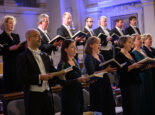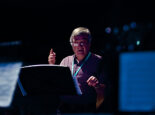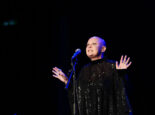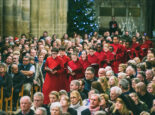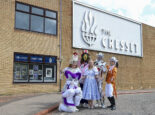Vivacity
WHERE DOES VIVACITY’S VOLUNTEER WORKERS FIT INTO ALL THIS?
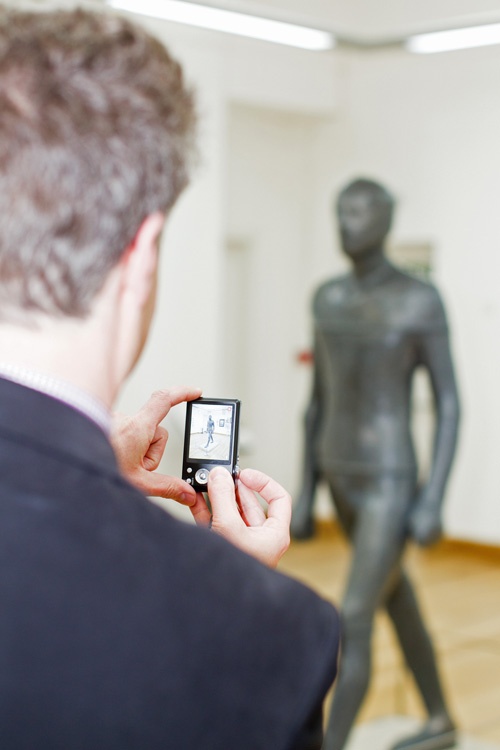 SS: You can look at volunteer workers in a number of ways but I see that what we do is give people an opportunity to make a contribution to their society and to the way they want their services to be run – and to have a part to play in that. We are very lucky in having lots of opportunities to be able to do that, whether it’s in the museum or in the Key Theatre or wherever. And I think that we should be developing those opportunities even further. We started from a premise of volunteers being able to carry out fairly simple tasks on an occasional basis, for one or two hours a week. But we found that there are a lot of very skilled people out there who have a real contribution to make that is perhaps a lot more thoughtful than just carrying out simple exercises. That requires a level of sophistication amongst our staff to be able to cope with, and understand, that and to be able to use people productively. A classic example of that is the board itself. The board is like any other board of directors of a company, in that the members have to have some fundamental skills to be able to run a company effectively. It’s really important to draw on those skills and have people who are willing to give the time and commitment to do what they would do in their professional lives, but to do it for the public good on a voluntary basis.
SS: You can look at volunteer workers in a number of ways but I see that what we do is give people an opportunity to make a contribution to their society and to the way they want their services to be run – and to have a part to play in that. We are very lucky in having lots of opportunities to be able to do that, whether it’s in the museum or in the Key Theatre or wherever. And I think that we should be developing those opportunities even further. We started from a premise of volunteers being able to carry out fairly simple tasks on an occasional basis, for one or two hours a week. But we found that there are a lot of very skilled people out there who have a real contribution to make that is perhaps a lot more thoughtful than just carrying out simple exercises. That requires a level of sophistication amongst our staff to be able to cope with, and understand, that and to be able to use people productively. A classic example of that is the board itself. The board is like any other board of directors of a company, in that the members have to have some fundamental skills to be able to run a company effectively. It’s really important to draw on those skills and have people who are willing to give the time and commitment to do what they would do in their professional lives, but to do it for the public good on a voluntary basis.
WHAT’S THE RATIO BETWEEN VOLUNTEERS AND PAID STAFF WITHIN VIVACITY?
KT: Volunteers now outnumber the paid staff. Initially, we had around 300 paid staff – not all of whom were full time – and around 90 volunteers. The number of paid staff has gone up slightly, so we’re not replacing paid staff with volunteers, but the number of volunteers has gone up massively, from around 90 to around 360. Two factors have driven that rise: one is that we have created opportunities for volunteers, and the other is that we’ve created the systems that allow them to come in and flourish, and that’s very important. One of the first things we did was appoint a member of staff with the job of enabling volunteers to come on board. You might be surprised to hear this regarding volunteers, but we drew up job descriptions for the positions and we listed personal specifications required, we held interviews too – everything you’d expect from a paid position. In return, we support them and enable them to do a good job.
Some of our volunteers are reaching the end of their career while others are very young and want to start a career and, in between the two of those there is every shade of black and white you can imagine. Some people want to come in and do a day, some want to do a particular programme like the Great Eastern Run (for which we sourced and deployed 270 volunteers for just one day’s work). We have a chap who works in one of our heritage venues who only does it for six months of the year because he only wants to work in summer time. So every single one of our volunteers has their own individual story.
ARE YOU STILL ENCOURAGING VOLUNTEERS TO COME FORWARD?
KT: Yes. We have a flow of volunteers – some only work with us for a few weeks – so we are always 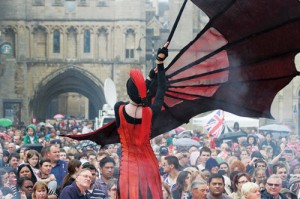 working with new people. And, of course, the things that Vivacity does are always changing so we have new opportunities all the time. Anyone who is interested can find details on our website at www.vivacity-peterborough.com
working with new people. And, of course, the things that Vivacity does are always changing so we have new opportunities all the time. Anyone who is interested can find details on our website at www.vivacity-peterborough.com
SS: We also have opportunities for interns and these are professional opportunities, if you like. Our work with volunteers has shown us how we can work with people differently. It’s about finding the right people with the right skills who can fill a particular slot that benefits both them and Vivacity. Moving into apprenticeships is really offering people job opportunities and valuable training which young people are really struggling to find at the moment.
KT: We’re looking to work with University College Peterborough to find people who want to do work experience as part of their academic study. So they’ll undertake their academic study and can then put it into practice with Vivacity. At the end of that process, they’ll have both academic and practical experience and that’s a powerful tool for any young person to have. So, for example, if someone’s interested in the creative industries then perhaps they could do the relevant academic course and then come and work for us at the Key Theatre to gain real world experience. So far this year we’ve had three people who have gone through this process and they’ve all had incredibly powerful experiences; so much so that one chap who did a year with us is now coming back
to work with us at weekends when he’s not at university. Next year we hope to have ten of these places available for people to benefit from this combination of education and work experience.
VIVACITY TOOK OVER IN MAY, 2010. WHAT ARE THE MAIN INITIATIVES YOU HAVE INSTIGATED SINCE THEN?
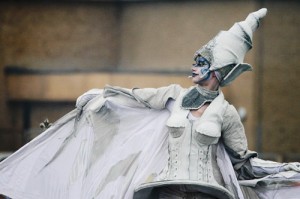 KT: I think our work with volunteers is something I would consider as a benchmark of excellence. And our work to become financially stable is a real lesson for many councils across the country. When we started, we promised the council that we would deliver all of the same services but to a higher standard, and we promised to deliver them for £1 million less (per year) than they were costing. We then said that, year on year, we would continue to improve the level of those services and would reduce costs by another £1 million over the next four years. So far we’re absolutely on track with that. In fact, last year we over-performed in terms of our own targets so we came up with some surpluses which we’re going to re-invest in the community. Every penny we make has to stay inside Peterborough and has to be used for the benefit of cultural opportunities. One example of that is the money we invested in community cricket wickets. There weren’t any pay-and-play public cricket squares in the area so we’re currently putting four new artificial turf wickets in place. That’s just one example of Vivacity injecting, in this instance, £100,000 worth of resources to move us from a situation of not having certain facilities to now having them.
KT: I think our work with volunteers is something I would consider as a benchmark of excellence. And our work to become financially stable is a real lesson for many councils across the country. When we started, we promised the council that we would deliver all of the same services but to a higher standard, and we promised to deliver them for £1 million less (per year) than they were costing. We then said that, year on year, we would continue to improve the level of those services and would reduce costs by another £1 million over the next four years. So far we’re absolutely on track with that. In fact, last year we over-performed in terms of our own targets so we came up with some surpluses which we’re going to re-invest in the community. Every penny we make has to stay inside Peterborough and has to be used for the benefit of cultural opportunities. One example of that is the money we invested in community cricket wickets. There weren’t any pay-and-play public cricket squares in the area so we’re currently putting four new artificial turf wickets in place. That’s just one example of Vivacity injecting, in this instance, £100,000 worth of resources to move us from a situation of not having certain facilities to now having them.
SS: I feel that one of our biggest achievements is in changing the way people go about their jobs now, compared to when they were working directly for the council. From the way they meet and greet the public to the way they think about how they’re performing, they realise now that what they do has an impact on the whole of Vivacity. The sports side of things is a good example. Most of the services we provide suck up money and it’s hard to get anything back but, on the sports side, it’s different and we can really generate income. And the people working in our sports facilities have done a brilliant job in maximising income. They know that the money they’re generating goes straight back into supporting more facilities in sport, or in the Key Theatre, or in the art galleries. When they were working for the council, they were more likely to think “Does it really matter if I sell five more gym memberships?” The money didn’t have the same influence on the way they worked. And if they did make any surplus, it probably went into filling pot holes or something else unrelated. But now, they’re working for an organisation that matters to them and they know that everything they do has an impact on that organisation and that’s led to a real positive and profound change in working practices.
KT: I think it’s an incredible journey that we’re on. We haven’t reached the pot of gold at the end of the rainbow yet but we are some considerable way down the line towards it. We’re doing lots and lots of little things that are also helping the bigger picture. For example, we designed our own customer care programme. It isn’t some meaningless one-day course – it’s a programme that lasts for
as long as you’re working for Vivacity. We’re also starting to feed back information to our staff. We’ve introduced something called a Balance Score Card which tells staff how well they’re doing and we’re giving them feedback in terms of how well our customers think we’re doing. All of these things are what big businesses do to make sure their staff are properly engaged and fully understand what they’re doing for the company or service.
CAN YOU EXPLAIN THE VIVACITY CARD?
KT: The Vivacity card is a central part of our marketing initiative. Marketing is all about knowing your customer and engaging your customer in a way that they want to be engaged. It’s also about understanding those customers and what sort of products they might want and how much they’d be prepared to pay for them, and in what way they’d want to receive those products or services. One of the problems that many organisations face is not having that information. Before Vivacity was created, that information did not exist – most of the council’s customers just came and went and we didn’t know very much about them. The Vivacity card is a way of capturing that information. The card itself is free and when you sign up to it, we find out your name, your address, and other useful information that helps us to target our services better. Through the card, you can buy services like gym membership, while other free services – like library membership – are on there too. t also offers reduced-cost access to things like our heritage facilities. So it’s one card that gets you lots of opportunities but it also allows us to know who you are and what kind of things you might like. Thousands of people have already signed up for the card but once it rolls out through our library we’ll be well over 100,000. We’re also exploring the possibility of it becoming a discount card so holders will be able to get money off products at certain stores.
SS: It also allows us to tell you about things which might interest you so, for example, we can let you know of an event that’s coming up at the Key Theatre if you recently took a book out from the library which was related to that show.










